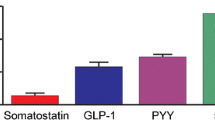Abstract
Gastric emptying was measured in female non-obese diabetic (NOD) mice with a duration of diabetes of 28–35 days. As controls, age- and sex-matched BLAB/cJ mice were used. Gastric emptying of diabetic mice was significantly slower than that of controls. The faeces weight and water content were significantly higher in diabetic mice than controls. The endocrine cells known to correlate with gastric emptying, namely secretin, serotonin, petide YY (PYY) and enteroglucagon cells, were identified by immunocytochemistry and quantified by computer image analysis. The densities of duodenal secretin, serotonin and colonic PYY cells in NOD mice were significantly higher than that of control mice. Changes in these three endocrine cell types may play a role in delayed gastric emptying and in the manifestation of diarrhoea in this animal model of human diabetes type 1.
Similar content being viewed by others
Author information
Authors and Affiliations
Additional information
Received: 15 December 2000 / Accepted in revised form: 25 June 2001
Rights and permissions
About this article
Cite this article
El-Salhy, M. Gastric emptying in an animal model of human diabetes type 1: relation to endocrine cells. Acta Diabetol 38, 139–144 (2001). https://doi.org/10.1007/s005920170011
Issue Date:
DOI: https://doi.org/10.1007/s005920170011




